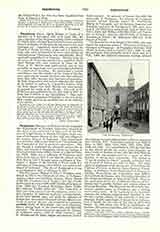

Perpignan, Diocese of (PERPINIANUM), comprises the Department of Pyrénées Orientales; created by the union of the ancient See of Elne, part of the Diocese of Urgel known as French Cerdagne, three cantons of the former Diocese of Alet, and two villages of the ancient Diocese of Narbonne. This department was united in 1802 to the Diocese of Carcassonne; by the Concordat of 1817 it received a special see. This see, though it continued the aforesaid ancient See of Elne, was located at Perpignan, where the bishops of Elne had resided since 1601 in virtue of a Bull of Clement VIII. Elne was a suffragan of Narbonne until 1511; from 1511 to 1517 it was directly subject to the Holy See; in 1517 it became again a suffragan of Narbonne; a Decree of the Council of Trent made it a suffragan of Tarragona; after 1678 it was again a suffragan of Narbonne. The See of Perpignan as it was reestablished in 1817 is suffragan to Albi.
The first known Bishop of Elne is Dominus, mentioned in 571 in the Chronicle of John of Biclarum. Among others are Cardinal Ascanio Maria Sforza (1494-95), Cardinal Caesar Borgia (1495-98), Cardinal Francois de Loris (1499-1506), Cardinal Jacques de Serra (1506-12), Cardinal Hieronimo Doria (1530-33); Olympe Gerbet (1854-64). The Cathedral of Elne (eleventh century) and the adjoining cloister are rich examples of elaborate medieval ornamentation. In the later Middle Ages, and under the influence of Roman law, Roussillon witnessed certain offensive revivals of ancient slavery; this is proved by numerous purchase deeds of Mussulman, and even Christian, slaves, dating back to the fourteenth and fifteenth centuries. The diocese honors especially St. Vincent de Collioure, martyr (end of third century); and St. Julalia and St. Julia, virgins and martyrs (end of third century). In memory of former ties with the metropolis of Tarragona, the Church of Perpignan honors several Spanish saints: St. Fructuosus, Bishop of Tarragona, and his deacons Augurius and Eulogius, martyred at Tarragona in 259; some martyrs of the Diocletian persecution (end of third century); Justa and Rufina of Seville; Felix and Narcissus of Gerona: Aciselus and Victoria of Cordova; Leocadia, of Toledo; St. Ildefonsus (607-67), Archbishop of Toledo.
The Benedictine Dom Briard (1743-1828), who continued the important series of “Historiens de France“, belonged to Perpignan. At Perpignan Benedict XIII (Pedro de Luna) held a council November 1, 1408, to rally his partisans; they gradually melted away and on February 1, 1409, the eighteen remaining bishops advised the antipope to send ambassadors to Pisa to negotiate with Gregory XII. Numerous councils were held at Elne: in 1027, 1058, 1114, 1335, 1337, 1338, 1339, 1340, and 1380. The council held in 1027 decreed that no one should attack his enemy from Saturday at nine o’clock to Monday at one; and that Holy Mass be said for the excommunicated for a space of three months, to obtain their conversion. The author of “l’Art de verifier les Dates” wrongly maintains that the Council of Elvira was held at Elne. The chief places of pilgrimage of the diocese are: Notre-Dame du Château d’Ultréra, at Sorède; Notre-Dame de Consolation, at Collioure; Notre-Dame de Font Romeu, at Odeillo; Notre-Dame de Forca-Réal, near Millas; Notre-Dame de Juigues, near Rivesaltes; the relics of Sts. Abdon and Sennen at Arles on the Tech. Prior to the application of the law of 1901, the Diocese of Perpignan had Capuchin Fathers and various orders of teaching Brothers. The Sisters of the Most Holy Sacrament, motherhouse at Perpignan, are a nursing and teaching order. At the beginning of the twentieth century the religious congregations directed in the diocese 1 infant school, 13 day nurseries, 1 boys’ orphanage, 2 girls’ orphanages, 8 hospitals or asylums, and 2 houses for the care of the sick in their own homes. In 1905 there were 212,121 inhabitants, 26 parishes, 197 succursal parishes, and 43 vicariates subventioned by the state.
GEORGES GOYAU

